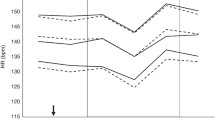Abstract
This was a randomized, double-blind trial to determine if a nutrient-enriched (preterm) formula supplemented with 0.2% docosahexaenoic acid (DHA, 22∶6n−3) from a low eicosapentaenoic acid (0.06%) source of marine oil would enhance visual novelty preference and attention of preterm infants. Both the standard and experimental formulas contained 3% of total fatty acids as linolenic acid (18∶3n−3) and were fed from approximately three days of age to two months past term. After two months, both diet groups were fed a commercially-available term formula with linolenic acid as the only source of n−3 fatty acid. At 12 mo visual recognition memory (novelty preference) and visual attention (number and duration of discrete looks) were determined with the Fagan Test of Infant Intelligence. The DHA-supplemented group compared with the control group had more and shorter duration looks in comparisons of familiar and novel stimuli, confirming earlier evidence that DHA can increase information processing speed of preterm infants who otherwise are receiving good intakes of linolenic acid. Because supplementation was stopped at two months and the effects seen at 12 mon, this study demonstrates for the first time that a relatively short period of DHA supplementation can produce significant effects on later visual attention.
Similar content being viewed by others
Abbreviations
- AA:
-
arachidonic acid
- BPD:
-
bronchopulmonary dysplasia
- DHA:
-
docosahexaenoic acid
- EPA:
-
eicosapentaenoic acid
- PE:
-
phosphatidylethanolamine
- PMA:
-
postmenstrual age
- RBC:
-
red blood cell
References
Carlson, S.E., Cooke, R., Werkman, S., and Peeples, J. (1989) Docosahexaenoate (DHA) and Eicosapentaenoate (EPA) Supplementation of Preterm (PT) Infants: Effects on Phospholipid DHA and Visual Acuity,FASEB J. 3, A1056.
Carlson, S.E., Werkman, S.H., Rhodes, P.G., and Tolley, E.A. (1993) Visual Acuity Development in Healthy Preterm Infants: Effect of Marine Oil Supplementation,Am. J. Clin. Nutr. 58, 35–42.
Carlson, S.E. (1993) Lipid Requirements of Very Low Birth Weight Infants for Optimal Growth and Development, inLipids, Learning and the Brain: Fats in Infant Formula, Report of the 103rd Ross Conference on Pediatric Research (Dobbing, J., and Benson, J.D., eds.) pp. 188–214, Ross Laboratories, Columbus.
Werkman, S.H., and Carlson, S.E. (1996) A Randomized Trial of Visual Attention of Preterm Infants Fed Docosahexaenoic Acid Until Nine Months,Lipids 31, 91–97.
Neuringer, M., Connor, W.E., Van Petten, C., and Barstad, L. (1984) Dietary Omega-3 Fatty Acid Deficiency and Visual Loss in Infant Rhesus Monkeys,J. Clin. Invest. 73, 272–276.
Reisbick, S., Neuringer, M., and Gohl, E. (1994) Increased Look Duration in Paired Comparisons by Rhesus Monkey Infants with n−3 Fatty Acid Deficiency (n−3 FAD),Soc. Neurosci. Abstr. 20, 1696.
Carlson, S.E., Cooke, R.J., Werkman, S.H., and Tolley, E.A. (1992) First Year Growth of Preterm Infants Fed Standard Compared to Marine Oil n−3 Supplemented Formula,Lipids 27, 901–907.
Carlson, S.E., Cooke, R.J., Rhodes, P.G., Peeples, J.M., Werkman, S.H., and Tolley, E.A. (1991) Long Term Feeding of Formulas High in Linolenic Acid and Marine Oil to Very Low Birth Weight Infants: Phospholipid Fatty Acids,Pediatr. Res. 30, 404–412.
Carlson, S.E., Werkman, S.H., Peeples, J.M., Cooke, R.J., and Tolley, E.A. (1993) Arachidonic Acid Status Correlates with First Year Growth in Preterm Infants,Proc. Natl. Acad. Sci. (U.S.A.) 90, 1073–1077.
Carlson, S.E., Werkman, S.H., and Tolley, E.A. (1996) The Effect of Long Chain n−3 Fatty Acid Supplementation on Visual Acuity and Growth of Preterm Infants with and without Bronchopulmonary Dysplasia,Am. J. Clin. Nutr. in press.
Ross Laboratories (1992)Ross Laboratories Product Handbook, pp. 36–37, 44–45, Ross Laboratories, Columbus.
Carlson, S.E., Koo, W.W.K., and Werkman, S.H. (1995) Omega-3 and Omega-6 Supplementation of Infants: Biochemistry, Visual Development and Growth,Proceedings from the Scientific Conference on Omega-3 Fatty Acids in Nutrition, Vascular Biology, and Medicine, pp. 47–59, American Heart Association, Dallas.
Farquharson, J., Cockburn, F., Patrick, W.A., Jamieson, E.C., and Logan, R.W. (1992) Infants Cerebral Cortex Phospholipid Fatty-Acid Composition and Diet,Lancet 340, 810–813.
Makrides, M., Neumann, M.A., Byard, R.W., Simmer, K., and Gibson, R.A. (1994) Fatty Acid Composition of Brain, Retina and Erythrocytes in Breast-Fed and Formula-Fed Infants,Am. J. Clin. Nutr. 60, 189–194.
Fagan, J.F., and Singer, L.T. (1983) Infant Recognition Memory as a Measure of Intelligence,Advances in Infancy Research (Lipsitt, L.P., ed.), Vol. 2, pp. 31–72, Ablex, Norwood.
Rose, S.A., and Wallace, I.F. (1985) Cross-Modal and Intramodal Transfer as Predictors of Mental Development in Full Term and Preterm Infants,Dev. Psychol. 21, 949–962.
Rose, S.A. (1983) Different Rates of Visual Information Processing in Full-Term and Preterm Infants,Child Dev. 54, 1189–1198.
Colombo, J., Mitchell, D.W., and Horowitz, F.D. (1988) Infant Visual Attention in the Paired-Comparison Paradigm: Test-Retest and Attention-Performance Relations,Child Dev. 59, 1198–1210.
Mitchell, D.W., and Colombo, J. (1989) Fixation Time as a Predictor of 3- and 4-Month-Olds’ Learning, Retention, and Transfer,Abstr. Soc. Res. Child Dev. 6, 321.
Rose, D.H., Slater, A., and Perry, H. (1986) Prediction of Childhood Intelligence from Habituation in Early Infancy,Intelligence 10, 251–263.
Colombo, J., and Mitchell, D.W. (1990) Individual Differences in Early Visual Attention: Fixation Time and Information Processing,Individual Differences in Infancy: Reliability, Stability, and Prediction (Colombo, J., and Fagan, J., eds.) pp. 193–227, Erlbaum, Hillsdale.
Colombo, J., Mitchell, D.W., Coldren, J.T., and Freeseman, L.J. (1991) Individual Differences in Infant Visual Attention: Are Short Lookers Faster Processors or Feature Processors?,Child Dev. 62, 1247–1257.
Johnson, M.H., Posner, M.I., and Rothbart, M.K. (1991) Components of Visual Orienting in Early Infancy: Contingency Learning, Anticipatory Looking, and Disengaging,J. Cognitive Neurosci. 3, 335–344.
Author information
Authors and Affiliations
Additional information
Based on a presentation at the AOCS Annual Meeting & Expo in San Antonio, Texas, May 7–11, 1995.
About this article
Cite this article
Carlson, S.E., Werkman, S.H. A randomized trial of visual attention of preterm infants fed docosahexaenoic acid until two months. Lipids 31, 85–90 (1996). https://doi.org/10.1007/BF02522416
Received:
Accepted:
Issue Date:
DOI: https://doi.org/10.1007/BF02522416




